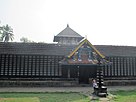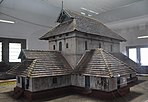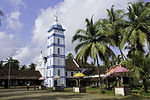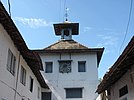Religion in Kerala
Religion in Kerala (2011 census)[1]
Religion in Kerala is diverse. According to 2011 census of India figures, 54.73% of Kerala's population are Hindus, 26.56% are Muslims, 18.38% are Christians, and the remaining 0.33% follow other religions or have no religion.[2] As of 2020, Hindus, Muslims, Christians and others account for 41.5%, 43.9%, 13.9% and 0.7% of the total child births in the state, respectively.[3]
The mythological legends regarding the origin of Kerala are Hindu in nature. Kerala produced several saints and movements. Adi Shankara was a religious philosopher who contributed to Hinduism and propagated the philosophy of Advaita. Hindus represent the biggest religious group in all districts except Malappuram, where they are outnumbered by Muslims.[4] Various tribal people in Kerala have retained the religious beliefs of their ancestors.[4][5] In comparison with the rest of India, Kerala experiences relatively little sectarianism.[6]
Hinduism

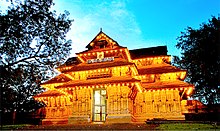
Several saints and movements existed. Adi Shankara was a Hindu philosopher who contributed to Hinduism and propagated philosophy of Advaita. He was instrumental in establishing four mathas at Sringeri, Dwarka, Puri and Jyotirmath. Melpathur Narayana Bhattathiri was another religious figure who composed Narayaniyam, a collection of verses in praise of Krishna.
Some of the most notable temples are: Ananthapura Lake Temple, Angadipuram Thirumandhamkunnu Temple, Alathiyoor Hanuman Temple, Bhayankavu Bhagavathi Temple, Kadampuzha Devi Temple, Keraladeshpuram Temple, Panniyur Sri Varahamurthy Temple, Sukapuram Dakshinamoorthy Temple, Thirunavaya Navamukunda Temple, Triprangode Siva Temple, Tali Shiva Temple, Trikkandiyur Siva Temple, Thrissur Vadakkunnathan Temple, Guruvayur Temple, Thriprayar Temple, Lokanarkavu Temple, Thirunelli Temple, Sabarimala Ayyappa Temple, Thiruvananthapuram Padmanabhaswamy Temple, Aranmula Parthasarathy Temple, Chottanikkara Temple, Chengannur Mahadeva Temple, Parassinikadavu Muthappan Temple, Chettikulangara Devi Temple, Mannarasala Temple, Chakkulathukavu Temple, Thiruvalla Sreevallabha Temple, Kaviyoor Mahadevar Temple, Parumala Panayannarkavu Temple, Sree Poornathrayesa Temple, Kodungallur Bhagavathy Temple, Trikkur Mahadeva Temple, Manalarkavu Devi Temple and Rajarajeshwara Temple. Temples in Kerala follow elaborate rituals and traditionally only priests from the Nambudiri caste could be appointed as priests in major temples. But in 2017 as per the state government's decision, the priests from the historically backward caste communities are now being appointed as priests.
Malayali Hindus practice ceremonies such as Chorunu (first feeding of rice to a child) and Vidyāraṃbhaṃ.[7]
Islam
- Islam is the second-largest practiced religion in Kerala (26.56%), only surpassed by Hinduism.[8] The calculated Muslim population (Indian Census, 2011) in Kerala state is 8,873,472.[9][10]
- Most of the Muslims in Kerala follow the Shāfiʿī School (Sunni Islam), followed by Salafi movement.[11]
- Muslims in Kerala share a common language (Malayalam) with the rest of the non-Muslim population and have a culture commonly regarded as the Malayali culture.[12]
- A number of different communities, some of them having distant ethnic roots, exist as status groups in Kerala.[13]
History
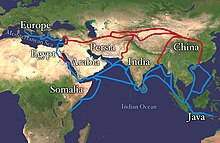

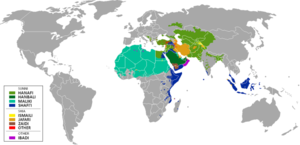
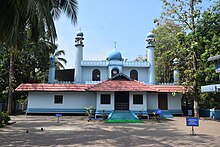
Kerala has been a major spice exporter since 3000 BCE, according to Sumerian records and it is still referred to as the "Garden of Spices" or as the "Spice Garden of India".[14][15]: 79 Kerala's spices attracted ancient Arabs, Babylonians, Assyrians and Egyptians to the Malabar Coast in the 3rd and 2nd millennia BCE. Phoenicians established trade with Kerala during this period.[16] Arabs and Phoenicians were the first to enter Malabar Coast to trade Spices.[16] The Arabs on the coasts of Yemen, Oman, and the Persian Gulf, must have made the first long voyage to Kerala and other eastern countries.[16] They must have brought the Cinnamon of Kerala to the Middle East.[16] The Greek historian Herodotus (5th century BCE) records that in his time the cinnamon spice industry was monopolized by the Egyptians and the Phoenicians.[16]
Islam arrived in Kerala, a part of the larger Indian Ocean rim, via spice and silk traders from the Middle East. Historians do not rule out the possibility of Islam being introduced to Kerala as early as the seventh century CE.[17][18] Notable has been the occurrence of Cheraman Perumal Tajuddin, the Hindu King that moved to Arabia to meet the Islamic Prophet Muhammad and converted to Islam.[19][20][21] Kerala Muslims are generally referred to as the Mappilas. Mappilas are but one among the many communities that forms the Muslim population of Kerala.[13][22] According to the Legend of Cheraman Perumals, the first Indian mosque was built in 624 AD at Kodungallur with the mandate of the last the ruler (the Cheraman Perumal) of Chera dynasty, who converted to Islam during the lifetime of Prophet Muhammad (c. 570–632).[23][24][25][26] According to Qissat Shakarwati Farmad, the Masjids at Kodungallur, Kollam, Madayi, Barkur, Mangalore, Kasaragod, Kannur, Dharmadam, Panthalayini, and Chaliyam, were built during the era of Malik Dinar, and they are among the oldest Masjids in the Indian subcontinent.[27] It is believed that Malik Dinar died at Thalangara in Kasaragod town.[28] According to popular tradition, Islam was brought to Lakshadweep islands, situated just to the west of Malabar Coast, by Ubaidullah in 661 CE. His grave is believed to be located on the island of Andrott.[29] A few Umayyad (661–750 AD) coins were discovered from Kothamangalam in the eastern part of Ernakulam district.[30]
The known earliest mention about Muslims of Kerala is in the Quilon Syrian copper plates of the 9th century CE, granted by the ruler of Kollam.[31] A number of foreign accounts have mentioned about the presence of considerable Muslim population in the Malabar Coast. Arab writers such as Al-Masudi of Baghdad (896–956 AD), Muhammad al-Idrisi (1100-1165 AD), Abulfeda (1273-1331 AD), and Al-Dimashqi (1256-1327 AD) mention the Muslim communities in Kerala.[32] Some historians assume that the Mappilas can be considered as the first native, settled Muslim community in South Asia.[25][33] Al-Biruni (973–1048 CE) appears to be the first writer to call Malabar Coast as Malabar.[34] Authors such as Ibn Khordadbeh and Al-Baladhuri mention Malabar ports in their works.[35] The Arab writers had called this place Malibar, Manibar, Mulibar, and Munibar. Malabar is reminiscent of the word Malanad which means the land of hills.[36] According to William Logan, the word Malabar comes from a combination of the Malayalam word Mala (hill) and the Persian/Arabic word Barr (country/continent).[36] The Kodungallur Mosque, has a granite foundation exhibiting 11th-12th century architectural style.[35] The Arabic inscription on a copper slab within the Madayi Mosque in Kannur records its foundation year as 1124 CE.[37][30][35]
The Muslims were a major financial power to be reckoned with in the old kingdoms of Kerala and had great political influence in the Hindu royal courts.[38][39] Travellers have recorded the considerably huge presence of Muslim merchants and settlements of sojourning traders in most of the ports of Kerala.[40] Immigration, intermarriage and missionary activity/conversion — secured by the common interest in the spice trade — helped in this development.[41][42] Muslim merchant magnates owning ships, spread their shipping and trading business interests across the Indian Ocean.[42][41] The Koyilandy Jumu'ah Mosque contains an Old Malayalam inscription written in a mixture of Vatteluttu and Grantha scripts which dates back to the 10th century CE.[43] It is a rare surviving document recording patronage by a Hindu king (Bhaskara Ravi) to the Muslims of Kerala.[43] A 13th century granite inscription, written in a mixture of Old Malayalam and Arabic, at Muchundi Mosque in Kozhikode mentions a donation by the king to the mosque.[44]
The Moroccan traveller Ibn Battutah (14th century) has recorded the considerably huge presence of Muslim merchants and settlements of sojourning traders in most of the ports of Kerala.[10] By the early decades of the 14th century, travellers speak of Calicut (Kozhikode) as the major port city in Kerala.[42] Some of the important administrative positions in the kingdom of Zamorin of Calicut, such as that of the port commissioner, were held by Muslims.[45] The port commissioner, the Shah Bandar, represented commercial interests of the Muslim merchants. In his account, Ibn Battutah mentions Shah Bandars in Calicut as well as Quilon (Ibrahim Shah Bandar and Muhammed Shah Bandar).[10][45] The Ali Rajas of Arakkal kingdom, based at Kannur, ruled the Lakshadweep Islands.[34] Arabs had the monopoly of trade in Malabar Coast and Indian Ocean until the Portuguese Age of Discovery.[34]
The arrival of the Portuguese traders in Malabar Coast in the late 15th century checked the then well-established and wealthy Muslim community's progress.[46] Following the discovery of sea route from Europe to Malabar in 1498, the Portuguese began to expand their territories and ruled the seas between Ormus and the Malabar Coast and south to Ceylon.[47][48] The Tuhfat Ul Mujahideen written by Zainuddin Makhdoom II (born around 1532) of Ponnani during 16th-century CE is the first-ever known book fully based on the history of Kerala, written by a Keralite. It is written in Arabic and contains pieces of information about the resistance put up by the navy of Kunjali Marakkar alongside the Zamorin of Calicut from 1498 to 1583 against Portuguese attempts to colonize Malabar coast.[49] It was first printed and published in Lisbon. A copy of this edition has been preserved in the library of Al-Azhar University, Cairo.[50][51][52] Tuhfatul Mujahideen also describes the history of Mappila Muslim community of Kerala as well as the general condition of Malabar Coast in the 16th century CE.[50] With the end of Portuguese era, Arabs lost their monopoly of trade in Malabar Coast.[34] By the mid-18th century the majority of the Muslims of Kerala became landless labourers, poor fishermen and petty traders, and the community was in "a psychological retreat".[46] The subsequent partisan rule of English East India Company authorities brought the land-less Muslim peasants of Malabar District into a condition of destitution, and this led to a series of uprisings (against the Hindu landlords and British administration). The series of violence eventually exploded as the infamous Mappila Uprising (1921–22).[46][12]
A large number of Muslims of Kerala found extensive employment in the Persian Gulf countries in the following years (c. 1970s). This widespread participation in the "Gulf Rush" produced huge economic and social benefits for the community. Great influx funds from the earnings of the employed followed. Issues such as widespread poverty, unemployment and educational backwardness began to change.[40]
Politics
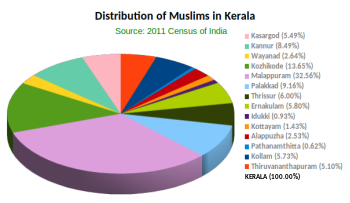
Politically speaking, Muslims in Kerala have exhibited more unanimity than any other major community in modern-day Kerala.[53]
- Ever since the country gained independence British rule in 1947, an overwhelming majority of Muslims at the former Malabar District (Northern Kerala) has supported the Muslim League.[53]
- In southern Kerala, the community generally supported the Indian National Congress and in northern Kerala a small proportion vote Communist.[53]
Christianity

Christianity is followed by 18.38% of the population of Kerala.[54] The Christianity in Kerala has long traditions from first century AD many of which is similar to the Malabari Jews,[55] the latter has settled in Kerala since the King Solomon.[56] According to traditional accounts,[57] Saint Thomas the Apostle visited Muziris in Kerala in the first century around 52 AD and proselytized some of the then settled Cochin Jewish families[58][59] and some Upper castes, they became the present "Mar Thoma Suriyani Nasrani" or Saint Thomas Syrian Christians.[60][61][62][63] According to traditional accounts, on the onset of an invasion Thomas is believed to have left northwest India traveled by vessel to the Malabar Coast, possibly visiting southeast Arabia and Socotra en route, and landing at the former flourishing port of Muziris (modern-day North Paravur and Kodungalloor).[59] Evidence such as the Acts of Thomas, one of the first accounts of the life of Thomas, say he died in Northwest India in the Indo-Parthian Kingdom, at the hands of the monarch Misdaeus, thought to be Abdagases I, a viceroy of the Gondopharnes in Sistan, modern day southern Afghanistan.[64] This conclusion is supported by Ephrem the Syrian and his contemporaries, Eusebius and Origen, who testify that Thomas evangelized the Parthians.[65] Modern scholars also support this point of view, and there is no evidence suggesting Thomas was ever in Kerala, or South India in general.[66][67] According to Knanaya Christians, an endogamous ethnic group found among the Saint Thomas Christian community of Kerala, their existence in Kerala is traced back to the arrival of the Syrian merchant Thomas of Cana (Knāi Thoma) who led a migration of Syriac Christians (Jewish-Christians) from Mesopotamia to India in the 4th or 9th century.[68][69][70] The Knanaya claim descent from Thomas of Cana and those who came with him. The communities arrival was recorded on the Thomas of Cana copper plates which existed in Kerala until the 17th century after which point they were taken to Portugal by the Franciscan Order.[71][72][73] Before the arrival of Europeans in Kerala there were only Marthoma Nasranis also called as Malankara Syrian Christians due to its historical, religious, and liturgical connection to Syriac Christianity. Marthoma Nasranis remained as an independent group, and they got their bishops from Church of the East until the advent of Portuguese and British colonialists. The first Roman Catholic Diocese in India was founded at Quilon in the year 1329 with the Catalan Dominican friar Jordanus Catalani as first Bishop.[74] The caste system became prevalent in Kerala later than any other parts of India after fourth and fifth century AD. The Nasranis were given special status outside the Varna system. Like Brahmins they were allowed to sit in front of Kings, ride on horse or elephants, to collect taxes. The Marthoma Nasranis back then also has the role of pollution neutralizers i.e., if a lower caste person hand over a substance to a Nasrani and if he in turn gives it to an upper caste, say for example Brahmin, then there would be no pollution for that Brahmin.[75]
The arrival of Europeans in the 15th century and discontent with Portuguese interference in religious matters fomented schism into Catholic and Orthodox communities. Further schism and rearrangements led to the formation of the other Indian Churches. Latin Catholics of Kerala has protracted over eleven centuries and the work of evangelization was revived by the western missionaries in the 13th century. Anglo-Indian Christian communities formed around this time as Europeans and natives intermarried. Protestantism took a stronghold in Kerala with missionary activity during British rule.
Denominations among all Christians in Kerala
The 2011 Indian census found a total of 6,411,269 Christians in Kerala,[76] with their various denominations as stated: Saint Thomas Christians (Syro-Malabar Church, Syro-Malankara Catholic Church, Malankara Orthodox Syrian Church, Jacobite Syrian Christian Church, CSI Syrian Christians, Mar Thoma Syrian Church, Pentecostal Syrian Christians, St. Thomas Evangelical Church of India, Chaldean Syrian Church and Malabar Independent Syrian Church)[77][78] constituted 70.73% of the Christians of Kerala, followed by Latin Catholics at 13.3%, Pentecostals at 4.3%, CSI at 4.5%, Dalit Christians at 2.6% and other Protestant groups (such as Lutheran, Calvinist and other charismatic churches) at 5.9%.
The Saint Thomas Christians (Nasrani) of Kerala primarily belongs to the churches which use the East Syriac Rite (Syro Malabar Church and Chaldean Syrian Church) and West Syriac Rite (Jacobite Syrian Christian Church, Malankara Orthodox Syrian Church, Mar Thoma Syrian Church, St. Thomas Evangelical Church of India, Syro-Malankara Catholic Church and the Malabar Independent Syrian Church). CSI Syrian Christians follow the Anglican rite. Pentecostal Saint Thomas Christians, like other Pentecostals, are riteless (nonliturgical).[79] The Saint Thomas Christians form 70.73% of the Christians of Kerala and 12.5% of the total population of Kerala.[80][81]

Around 61% of Christians in the state are Catholics which includes the Eastern Syrian Catholics (Syro-Malabar Church and Syro-Malankara Catholic Church) and the Latin Catholics of Kerala.[82] The Oriental Orthodox Churches are Malankara Orthodox Syrian Church and Malankara Jacobite Syriac Orthodox Church. The Malankara Marthoma Syrian Church is an Oriental Protestant church. The Church of South India belong to the Anglican Communion. Major Pentecostal denominations in Kerala include the India Pentecostal Church of God, Assemblies of God in India, Church of God (Full Gospel) in India, and The Pentecostal Mission. There has been a strong presence of other Protestant groups in southern Kerala such as the Church of South India and The Salvation Army that are typically based on Anglican beliefs and trace their origins to British rule. They have a significant presence in Neyyattinkara taluk and Pathanamthitta district.
In 2023, the BBC reported on the Christian tradition of photographing funerals in Kerala. [83]
Judaism
Judaism arrived in Kerala with spice traders, possibly as early as the 7th century BC.[84] There is no consensus of opinion on the date of the arrival of the first Jews in India. The tradition of the Cochin Jews maintains that after 72 AD, after the destruction of the Second Temple of Jerusalem, 10,000 Jews migrated to Kerala.[84]
The only verifiable historical evidence about the Kerala Jews goes back only to the Jewish Copper Plate Grant of Bhaskara Ravi Varman in 1000 AD.[85] This document records the royal gift of rights and privileges to the Jewish Chief of Anjuvannam Joseph Rabban. Later in the 16th century many Jews from Portugal and Spain settled in Cochin. These Jews were called white Jews as opposed to the native black Jews.

The Portuguese did not look favorably on the Jews. They destroyed the Jewish settlement in kodungallur and sacked the Jewish town in Cochin and partially destroyed the famous Cochin Synagogue in 1661. However, the Dutch were more tolerant and allowed the Jews to pursue their normal life and trade in Cochin. According to the testimony of the Dutch Jew, Moses Pereira De Paiva, in 1686 there were 10 synagogues and nearly 500 Jewish families in Cochin. Later Britishers too were tolerant. The Jews were protected. After the creation of the State of Israel in 1948, most Jews decided to emigrate to Israel. Most of the emigrants to Israel between 1948 and 1955 were from the community of black Jews and brown Jews; they are known as Cochini in Israel. Since the 1960s, only a few hundred Jews (mostly white Jews) remained in Kerala with only two synagogues open for service: the Pardesi Synagogue in Matancherry built in 1567 and the synagogue in Parur.[citation needed]
Jainism

Jainism, one of the three most ancient Indian religious traditions still in existence, has very small presence (0.01%) in Kerala, in south India. According to the 2011 India Census, Kerala only has around 4500 Jains, most of them in the city of Cochin and in Wayanad district.
Medieval Jain inscriptions are mostly found on the borders of Kerala proper, such Wynad in north-east, Alathur in the Palghat Gap and Chitharal in Kanyakumari District. Epigraphical evidence suggests that the shrine at "Tirukkunavay", perhaps located near Cochin, was the major Jain temple in medieval Kerala (from c. 9th century AD). The so-called "Rules of the Tirukkunavay Temple" provided model and precedent for all other Jain temples of Kerala.[86] A number of images of Mahavira, Padmavati, and Parsvanatha have been recovered from Kerala.[86]
Some of the Jain temples in Kerala were taken over by the Hindus at a later stage. The temple images are worshiped as Hindu gods and considered as part of the Hindu pantheon. It is not uncommon for Hindus and Jains to worship their deities in the same temple.[86]
Buddhism
Buddhism probably flourished for 200 years (650-850) in Kerala. The Paliyam Copper Plate of the Ay King, Varaguna (885-925 AD)[87] shows that the Buddhists benefited from royal patronage in the 10th century.
The religion's popularity declined following the onset of Advaita Vedanta propagated by sage Shankaracharya.[88]
However there remain Buddhist sites and traditions across Kerala.
Parsi (Zoroastrianism)
There were a number of Parsi families settled in Kerala, particularly around Kozhikode and Thalassery area. They practiced Zoroastrianism and even built the 160-year-old dadgah (fire temple) at S. M. Street, Kozhikode which is still in existence. They were mostly wealthy families who immigrated during the 18th century from Gujarat and Bombay. The community included famous families such as the Hirjis or Marshalls.[89] Some famous Malayali Parsis included the reputed Dr. Kobad Mogaseb, who was the first medical doctor from Kozhikode who graduated from London, as well as Kaikose Rudreshan who funded the Basel Evangelical Mission Parsi High School, Thalassery.[90]
Tribal and other religious faiths
Various groups classified as tribes in Kerala still dominate various remote and hilly areas of Kerala.[91] They have retained various rituals and practices of their ancestors despite influences of mainstream religions.
Dinkoism
Dinkoism in a parody religion created by atheist communities in the state, centred around the 'worship' of Dinkan, a mouse superhero from the discontinued children's magazine Balamangalam.
Demographics
| Census Year |
Hindus | Decadal Growth rate (%) | Muslims | Decadal Growth rate (%) | Christians | Decadal Growth rate (%) | Total Population |
Decadal Growth rate (%) | ||||
|---|---|---|---|---|---|---|---|---|---|---|---|---|
| 1901 | 4,378,305 | 68.5% | N/A | 1,119,473 | 17.5% | N/A | 891,767 | 13.9% | N/A | 6,389,545 | 100.0% | N/A |
| 1911 | 4,762,393 | 66.8% | +8.77 | 1,263,602 | 17.7% | +12.87 | 1,101,289 | 15.5% | +23.50 | 7,127,284 | 100.0% | +11.55 |
| 1921 | 5,052,039 | 64.9% | +6.08 | 1,360,180 | 17.5% | +7.64 | 1,376,354 | 17.7% | +24.98 | 7,788,573 | 100.0% | +9.28 |
| 1931 | 6,021,982 | 63.4% | +19.20 | 1,624,112 | 17.1% | +19.40 | 1,856,024 | 19.5% | +34.85 | 9,502,118 | 100.0% | +22.00 |
| 1941 | 6,699,600 | 61.8% | +11.25 | 1,883,786 | 17.4% | +11.60 | 2,263,888 | 20.9% | +21.98 | 10,847,274 | 100.0% | +14.16 |
| 1951 | 8,344,351 | 61.6% | +24.55 | 2,374,598 | 17.5% | +26.05 | 2,825,720 | 20.9% | +24.82 | 13,544,669 | 100.0% | +24.87 |
| 1961 | 10,282,568 | 60.9% | +23.23 | 3,027,639 | 17.9% | +27.50 | 3,587,365 | 21.2% | +26.95 | 16,897,572 | 100.0% | +24.75 |
| 1971 | 12,683,277 | 59.4% | +23.35 | 4,162,718 | 19.5% | +37.49 | 4,494,089 | 21.1% | +25.28 | 21,340,084 | 100.0% | +26.29 |
| 1981 | 14,801,347 | 58.2% | +16.70 | 5,409,687 | 21.3% | +30.00 | 5,233,865 | 20.6% | +16.46 | 25,444,899 | 100.0% | +19.24 |
| 1991 | 16,668,587 | 57.3% | +12.62 | 6,788,354 | 23.3% | +25.49 | 5,621,510 | 19.3% | +7.41 | 29,078,451 | 100.0% | +14.28 |
| 2001 | 17,920,105 | 56.3% | +7.51 | 7,863,842 | 24.7% | +15.84 | 6,057,427 | 19.0% | +7.75 | 31,841,374 | 100.0% | +9.50 |
| 2011 | 18,282,492 | 54.9% | +2.02 | 8,873,472 | 26.6% | +12.84 | 6,141,269 | 18.4% | +1.38 | 33,406,061 | 100.0% | +4.91 |
| Indicates Least growth rate | Indicates Most growth rate | Source: Census of India (1901 - 2011) | ||||||||||
Religious demographics of Travancore (1816-1941)
| Census year | Total population | Hindus | Christians | Muslims | |||
|---|---|---|---|---|---|---|---|
| 1816 - 1820 | 906,587[95] | 752,371[95] | 82.99% | 112,158[95] | 12.37% | 42,058[95] | 4.64% |
| 1881 | 2,401,158[96] | 1,755,610[96] | 73.12% | 498,542[96] | 20.76% | 146,909[96] | 6.12% |
| 1891 | 2,557,736[97] | 1,871,864[97] | 73.18% | 526,911[97] | 20.60% | 158,823[97] | 6.21% |
| 1901 | 2,952,157[95] | 2,063,798[95] | 69.91% | 697,387[95] | 23.62% | 190,566[95] | 6.46% |
| 1911 | 3,428,975[95] | 2,298,390[95] | 67.03% | 903,868[95] | 26.36% | 226,617[95] | 6.61% |
| 1921 | 4,006,062[95] | 2,562,301[95] | 63.96% | 1,172,934[95] | 29.27% | 270,478[95] | 6.75% |
| 1931 | 5,095,973[95] | 3,137,795[95] | 61.57% | 1,604,475[95] | 31.46% | 353,274[95] | 6.93% |
| 1941 | 6,070,018[98] | 3,671,480[98] | 60.49% | 1,963,808[98] | 32.35% | 434,150[98] | 7.15% |
Religious Demographics of Malabar District (1871 - 1951)
| Religion | 1871[99] | 1951[100] | |
| 1 | Hinduism | 72.43% | 63.25% |
|---|---|---|---|
| 2 | Islam | 25.72% | 33.49% |
| 3 | Christianity | 1.43% | 3.24% |
Population by religion, per 2011 census
| Religion | Population | % | Population below 6 yrs of age[101] | % | Dist. with highest Population | Dist. with lowest Population | Population growth since 2001 |
|---|---|---|---|---|---|---|---|
| Hindus | 18,282,492 | 54.73 | 1,632,777 | 47.01 | Thiruvananthapuram | Wayanad | 2.23% |
| Muslims | 8,873,472 | 26.56 | 1,276,104 | 36.74 | Malappuram | Pathanamthitta | 12.84% |
| Christians | 6,141,269 | 18.38 | 546,897 | 15.75 | Ernakulam | Malappuram | 1.38% |
Population by religion, per 2001 census
| Religion | Population | % | Population below 6 yrs of age[4] | % | Dist. with highest Population | Dist. with lowest Population | Population growth since 1991 | Children born per women (TFR)[102] |
|---|---|---|---|---|---|---|---|---|
| Hindus | 17,883,449 | 56.2 | 1,932,504 | 50.78 | Thiruvananthapuram | Waynad | 7.29% | 1.64 |
| Muslims | 7,863,342 | 24.3 | 1,178,880 | 30.99 | Malappuram | Pathanamthitta | 15.84% | 2.46 |
| Christians | 6,057,427 | 19 | 677,878 | 17.82 | Ernakulam | Malappuram | 7.75% | 1.88 |
Population from 2001 and 2011 census, with percentage by religion for each district[clarification needed]
| Districts | Population(2001) | Population(2011) | Percent Hindus | Percent Muslims | Percent Christians |
|---|---|---|---|---|---|
| Kasargod | 1,203,342 | 1,307,375 | 55.83% | 37.24% | 6.68% |
| Kannur | 2,412,365 | 2,523,003 | 59.83% | 29.43% | 10.41% |
| Wayanad | 786,627 | 817,420 | 49.48% | 28.65% | 21.34% |
| Kozhikode | 2,878,498 | 3,086,293 | 56.21% | 39.24% | 4.26% |
| Malappuram | 3,629,640 | 4,112,920 | 27.60% | 70.24% | 1.98% |
| Palakkad | 2,617,072 | 2,809,934 | 66.76% | 28.93% | 4.07% |
| Thrissur | 2,975,440 | 3,121,200 | 58.42% | 17.07% | 24.27% |
| Ernakulam | 3,098,378 | 3,282,388 | 45.99% | 15.67% | 38.03% |
| Idukki | 1,128,605 | 1,108,974 | 48.86% | 7.41% | 43.42% |
| Kottayam | 1,952,901 | 1,974,551 | 49.81% | 6.41% | 43.48% |
| Alappuzha | 2,105,349 | 2,127,789 | 68.64% | 10.55% | 20.45% |
| Pathanamthitta | 1,231,577 | 1,197,412 | 56.93% | 4.59% | 38.12% |
| Kollam | 2,584,118 | 2,635,375 | 64.42% | 19.29% | 15.99% |
| Thiruvananthapuram | 3,234,707 | 3,301,427 | 66.94% | 13.72% | 19.10% |
Births by Religion in Kerala in 2019[5]
| Religion | 2021[104] | % | 2020[105] | % | 2019 | % | 2018[5] | % | 2017[106] | % | 2016[107] | % | 2015[108] | % | 2014[109] | % | 2013[110] | % | 2012[111] | % | 2011[112] | % | 2010[113] | % | 2009[114] | % | 2008[115] | % | 2007[116] | % | 2006[117] | % | 2005[118] | % |
|---|---|---|---|---|---|---|---|---|---|---|---|---|---|---|---|---|---|---|---|---|---|---|---|---|---|---|---|---|---|---|---|---|---|---|
| Muslim | 169,296 | 40.33% | 196,138 | 43.89% | 212,933 | 44.35% | 213,805 | 43.80% | 216,525 | 43.00% | 211,182 | 42.55% | 213,865 | 41.45% | 218,437 | 40.87% | 214,257 | 39.96% | 175,892 | 31.96% | 214,099 | 38.21% | 209,276 | 38.26% | 204,711 | 37.61% | 194,583 | 36.32% | 183,796 | 33.71% | 196,493 | 35.32% | 191,675 | 34.28% |
| Hindu | 181,396 | 43.21% | 185,411 | 41.49% | 197,061 | 41.04% | 203,158 | 41.61% | 210,071 | 41.71% | 207,831 | 41.88% | 221,220 | 42.87% | 231,031 | 43.23% | 236,420 | 44.08% | 214,591 | 38.99% | 248,610 | 44.37% | 246,297 | 45.03% | 247,707 | 45.51% | 241,305 | 45.04% | 250,094 | 45.88% | 258,119 | 46.40% | 262,976 | 47.04% |
| Christian | 59,766 | 14.24% | 62,265 | 13.93% | 68,596 | 14.28% | 69,844 | 14.31% | 75,335 | 14.96% | 76,205 | 15.35% | 79,565 | 15.42% | 83,616 | 15.65% | 84,660 | 15.78% | 102,546 | 18.63% | 94,664 | 16.90% | 88,936 | 16.26% | 90,451 | 16.62% | 94,175 | 17.58% | 98,220 | 18.02% | 96,469 | 17.34% | 98,353 | 17.59% |
| Others | 9,143 | 2.18% | 2,967 | 0.66% | 1408 | 0.29% | 1,214 | 0.25% | 1,497 | 0.30% | 852 | 0.18% | 933 | 0.18% | 1,178 | 0.22% | 869 | 0.16% | 57,215 | 10.39% | 2,671 | 0.48% | 651 | 0.12% | 704 | 0.13% | 5,151 | 0.96% | 6,108 | 1.12% | 1,545 | 0.28% | 1,098 | 0.19% |
| Not Stated | 166 | 0.04% | 110 | 0.02% | 115 | 0.04% | 153 | 0.03% | 160 | 0.03% | 222 | 0.04% | 430 | 0.08% | 196 | 0.03% | 146 | 0.02% | 167 | 0.03% | 224 | 0.04% | 1,806 | 0.33% | 775 | 0.14% | 524 | 0.10% | 6,936 | 1.27% | 3,700 | 0.66% | 4,980 | 0.89% |
| Total | 419,767 | 100% | 446,891 | 100% | 480,113 | 100% | 488,174 | 100% | 503,588 | 100% | 496,292 | 100% | 516,013 | 100% | 534,458 | 100% | 536,352 | 100% | 550,411 | 100% | 560,268 | 100% | 546,964 | 100% | 544,348 | 100% | 535,738 | 100% | 545,154 | 100% | 556,326 | 100% | 559,082 | 100% |
See also
References
- ^ "Population by religious community - 2011". 2011 Census of India. Office of the Registrar General & Census Commissioner. Archived from the original on 25 August 2015. Retrieved 25 August 2015.
- ^ "Population by religious communities – Census of India". Retrieved 26 August 2015.
- ^ "Annual Vital Statistics Report – 2020, Page Number 109" (PDF). Government of Kerala, Vital Statistics Division, Department of Economics & Statistics, Thiruvananthapuram. Retrieved 8 July 2022.
- ^ a b c "Increase in Muslim population in the State". The Hindu. Chennai, India. 23 September 2004. Archived from the original on 28 November 2004.
- ^ a b c "Annual Vital Statistics Report – 2018, Page Number 92" (PDF). Government of Kerala, Vital Statistics Division Department of Economics & Statistics Thiruvananthapuram. Retrieved 29 September 2020.
- ^ Heller P (4 May 2003). "Social capital as a product of class mobilization and state intervention: Industrial workers in Kerala, India". University of California: 49–50.
{{cite journal}}: Cite journal requires|journal=(help) - ^ "Vidyarambham celebrated in Kerala - India News - IBNLive". Ibnlive.in.com. Archived from the original on 3 October 2012. Retrieved 24 August 2011.
- ^ Panikkar, K. N., Against Lord and State: Religion and Peasant Uprisings in Malabar 1836–1921
- ^ T. Nandakumar, "54.72 % of population in Kerala are Hindus" The Hindu August 26, 2015 [1]
- ^ a b c Miller, Roland E. (27 April 2015). Mappila Muslim Culture. State University of New York Press. p. xi. ISBN 978-1-4384-5601-0.
- ^ Miller, Roland. E., "Mappila" in "The Encyclopedia of Islam". Volume VI. E. J. Brill, Leiden. 1987 pp. 458-56.
- ^ a b Pg 461, Roland Miller, The Encyclopaedia of Islam, Vol VI, Brill 1988
- ^ a b Kunhali, V. "Muslim Communities in Kerala to 1798" PhD Dissertation Aligarh Muslim University (1986).[2]
- ^ Pradeep Kumar, Kaavya (28 January 2014). "Of Kerala, Egypt, and the Spice link". The Hindu. Retrieved 12 November 2015.
- ^ Chattopadhyay, Srikumar; Franke, Richard W. (2006). Striving for Sustainability: Environmental Stress and Democratic Initiatives in Kerala. Concept Publishing Company. ISBN 978-81-8069-294-9.
- ^ a b c d e A Sreedhara Menon (1 January 2007). A Survey Of Kerala History. DC Books. pp. 57–58. ISBN 978-81-264-1578-6. Retrieved 10 October 2012.
- ^ Sethi, Atul (24 June 2007). "Trade, not invasion brought Islam to India". Times of India. Retrieved 24 September 2014.
- ^ Katz 2000; Koder 1973; Thomas Puthiakunnel 1973; David de Beth Hillel, 1832; Lord, James Henry 1977.
- ^ Varghese, Theresa (2006). Stark World Kerala. Stark World Pub. ISBN 9788190250511.
- ^ Kumar, Satish (27 February 2012). India's National Security: Annual Review 2009. Routledge. ISBN 9781136704918.
- ^ Minu Ittyipe; Solomon to Cheraman; Outlook Indian Magazine; 2012
- ^ Chitra Divakaruni (16 February 2011). The Palace of Illusions. Pan Macmillan. ISBN 978-0-330-47865-6. Retrieved 18 November 2012.
- ^ Jonathan Goldstein (1999). The Jews of China. M. E. Sharpe. p. 123. ISBN 9780765601049.
- ^ Edward Simpson; Kai Kresse (2008). Struggling with History: Islam and Cosmopolitanism in the Western Indian Ocean. Columbia University Press. p. 333. ISBN 978-0-231-70024-5. Retrieved 24 July 2012.
- ^ a b Uri M. Kupferschmidt (1987). The Supreme Muslim Council: Islam Under the British Mandate for Palestine. Brill. pp. 458–459. ISBN 978-90-04-07929-8. Retrieved 25 July 2012.
- ^ Husain Raṇṭattāṇi (2007). Mappila Muslims: A Study on Society and Anti Colonial Struggles. Other Books. pp. 179–. ISBN 978-81-903887-8-8. Retrieved 25 July 2012.
- ^ Prange, Sebastian R. Monsoon Islam: Trade and Faith on the Medieval Malabar Coast. Cambridge University Press, 2018. 98.
- ^ Pg 58, Cultural heritage of Kerala: an introduction, A. Sreedhara Menon, East-West Publications, 1978
- ^ "History". lakshadweep.nic.in. Archived from the original on 14 May 2012. Retrieved 1 August 2012.
- ^ a b Miller, Roland E. (1988). "Mappila". The Encyclopedia of Islam. Vol. VI. E. J. Brill. pp. 458–66.
- ^ Cereti, C. G. (2009). "The Pahlavi Signatures on the Quilon Copper Plates". In Sundermann, W.; Hintze, A.; de Blois, F. (eds.). Exegisti Monumenta: Festschrift in Honour of Nicholas Sims-Williams. Wiesbaden: Harrassowitz. ISBN 9783447059374.
- ^ Razak, Abdul (2013). Colonialism and community formation in Malabar: a study of Muslims of Malabar.
- ^ A. Rā Kulakarṇī (1996). Mediaeval Deccan History: Commemoration Volume in Honour of Purshottam Mahadeo Joshi. Popular Prakashan. pp. 54–55. ISBN 978-81-7154-579-7. Retrieved 24 July 2012.
- ^ a b c d A Survey of Kerala History, A. Sreedhara Menon, DC Books, Kottayam (2007)
- ^ a b c Muhammad, K. M. (1999). Arab Relations with Mlabar Coast from 9th to 16th centuries. Proceedings of the Indian History Congress. pp. 226–234.
- ^ a b William Logan (1887). Malabar Manual (Volume-I). Madras Government Press.
- ^ Charles Alexander Innes (1908). Madras District Gazetteers Malabar (Volume-I). Madras Government Press. pp. 423–424.
- ^ Menon, A. Sreedhara (1982). The Legacy of Kerala (Reprinted ed.). Department of Public Relations, Government of Kerala. ISBN 978-8-12643-798-6. Retrieved 16 November 2012.
- ^ Mehrdad Shokoohy (29 July 2003). Muslim Architecture of South India: The Sultanate of Ma'bar and the Traditions of the Maritime Settlers on the Malabar and Coromandel Coasts (Tamil Nadu, Kerala and Goa). Psychology Press. p. 144. ISBN 978-0-415-30207-4. Retrieved 30 July 2012.
- ^ a b Miller, E. Roland. "Mappila Muslim Culture" State University of New York Press, Albany (2015); p. xi.
- ^ a b Miller, R. E. "Mappila" in The Encyclopedia of Islam Volume VI. Leiden E. J. Brill 1988 p. 458-66 [3]
- ^ a b c Prange, Sebastian R. Monsoon Islam: Trade and Faith on the Medieval Malabar Coast. Cambridge University Press, 2018.
- ^ a b Aiyer, K. V. Subrahmanya (ed.), South Indian Inscriptions. VIII, no. 162, Madras: Govt of India, Central Publication Branch, Calcutta, 1932. p. 69.
- ^ M. G. S. Narayanan. "Kozhikkodinte Katha". Malayalam/Essays. Mathrubhumi Books. Second Edition (2017) ISBN 978-81-8267-114-0
- ^ a b K. V. Krishna Iyer, Zamorins of Calicut: From the earliest times to AD 1806. Calicut: Norman Printing Bureau, 1938.
- ^ a b c Nossiter, Thomas Johnson (January 1982). Communism in Kerala: A Study in Political Adaptation. ISBN 9780520046672. Retrieved 15 November 2012.
- ^ Sanjay Subrahmanyam, The Career and Legend of Vasco da Gama, Cambridge University Press, 1997, 288
- ^ Knox, Robert (1681). An Historical Relation of the Island Ceylon. London: Reprint. Asian Educational Services. pp. 19–47.
- ^ AG Noorani "Islam in Kerala". Archived from the original on 21 December 2012. Retrieved 5 January 2013.
- ^ a b A. Sreedhara Menon. Kerala History and its Makers. D C Books (2011)
- ^ A G Noorani. Islam in Kerala. Books [4]
- ^ Roland E. Miller. Mappila Muslim Culture SUNY Press, 2015
- ^ a b c Nossiter, T. J. "Communism in Kerala: A Study in Political Adaptation" C. Hurst and Company, London (1982) p. 23-25
- ^ "2011 Census of India. C-1 Population By Religious Community". Office of the Registrar General & Census Commissioner, India Ministry of Home Affairs, Government of India.
- ^ Frykenberg. 2008. p. 99.
- ^ The Jews of India: A story of Three Communities. Israel Museum: UPNE. 1995. p. 27. ISBN 978-965-278-179-6.
- ^ "What historical proof is there that St Thomas did come to India? Any documentation or indications that he really did come to Kerala? | Edin Michael". www.catholic.cafe/. 12 February 2020. Retrieved 8 January 2022.
- ^ Mundadan & Thekkedath. 1982. pp. 30–32.
- ^ a b "History | PAYYAPPILLY PALAKKAPPILLY NASRANI". www.payyappilly.org. Retrieved 16 April 2020.
- ^ The Encyclopedia of Christianity, Volume 5 by Erwin Fahlbusch. Wm. B. Eerdmans Publishing - 2008. p. 285. ISBN 978-0-8028-2417-2.
- ^ Medlycott, A E. 1905 "India and the Apostle Thomas"; Gorgias Press LLC; ISBN
- ^ Stephen Neill (2 May 2002). A History of Christianity in India: 1707–1858. Cambridge University Press. p. 237. ISBN 978-0-521-89332-9. Retrieved 31 August 2012.
- ^ "Why Christo-Racist Nationalism and Anti-Muslim Rhetoric Are Gaining Ground in Kerala". The Wire. Retrieved 22 June 2021.
- ^ "VIII.— On Two Medieval Bronze Bowls in the British Museum. By O. M. Dalton, Esq., M.A, F.S.A" (PDF).
Gondopharnes, the first of the 'Indian kings' to whom he is said to have come, is an historical ruler who represented the Parthian power in Seistan and Kandahar, the Kabul Valley and North Western India; his reign began in A.D. 19, and had not ended in A.D. 45. The identity of Misdaeus' (Mazdai), the second king visited, under whom St. Thomas suffered martyrdom, is less certain; he may possibly have been Abdagases, viceroy of Gondopharnes in Seistan. See E. J. Rapson, The Cambridge History of India, vol. i, 1922, pp. 576-80
- ^ Cordier, Henri (1920). Marco Polo; notes and addenda to Sir Henry Yule's edition, containing the results of recent research and discovery.
St. Ephraem the Syrian (born about A.D. 300, died about 378), who spent most of his life at Edessa, in Mesopotamia, states that the Apostle was martyred in ' India,' and that his relics were taken thence to Edessa. That St. Thomas evangelized the Parthians, is stated by Origen (born A.D. 185 or 186, died about 251-254). Eusebius (bishop of Caesarea Palaestinae from A.D. 315 to about 340) says the same
- ^ Cordier, Henri (1920). Marco Polo; notes and addenda to Sir Henry Yule's edition, containing the results of recent research and discovery.
There is no evidence at all that the place where St. Thomas was martyred was in Southern India; and all the indications point to another direction
- ^ Medlycott. 1905. pp. 18–71.
- ^ Baum, Wilhelm; Winkler, Dietmar W. (8 December 2003). The Church of the East. Routledge. doi:10.4324/9780203423097. ISBN 978-0-203-42309-7.
- ^ "Author Index Vol. 60, 2005". Human Heredity. 60 (4): 242. 2005. doi:10.1159/000091316. ISSN 0001-5652. S2CID 202648744.
- ^ Wallich, Paul (June 1990). "Peary Redux". Scientific American. 262 (6): 25–26. Bibcode:1990SciAm.262f..25W. doi:10.1038/scientificamerican0690-25. ISSN 0036-8733.
- ^ "Socialist Politics Post-Mitterrand 1988-2002", Exceptional Socialists, Palgrave Macmillan, 2014, doi:10.1057/9781137318688.0012, ISBN 978-1-137-31868-8, retrieved 24 October 2020
- ^ "Obesitasrichtlijnen". Huisarts en Wetenschap. 48 (7): 497. July 2005. doi:10.1007/bf03084328. ISSN 0018-7070.
- ^ Mundadan AM (1984). Volume I: From the Beginning up to the Sixteenth Century (up to 1542). History of Christianity in India. Church History Association of India. Bangalore: Theological Publications.
- ^ "Index - Quilon DIocese". www.quilondiocese.com. Retrieved 14 October 2019.
- ^ Varghese, Philip (2010). Introduction to Caste in Christianity: A Case of Kerala. p. 12. SSRN 2694487.
- ^ "Census of India". Retrieved 12 April 2009.
- ^ Frykenberg, Robert Eric (27 June 2008). Christianity in India: From Beginnings to the Present. OUP Oxford. p. 249. ISBN 978-0-19-154419-4.
- ^ "Thomas Christians: History & Tradition-Britannica". www.britannica.com.
- ^ John, Stanley J. Valayil C. (19 February 2018). Transnational Religious Organization and Practice: A Contextual Analysis of Kerala Pentecostal Churches in Kuwait. BRILL. pp. 167, 203. ISBN 978-90-04-36101-0.
- ^ Anderson, Allan; Tang, Edmond (2005). Asian and Pentecostal: The Charismatic Face of Christianity in Asia. OCMS. pp. 192 to 193, 195 to 196, 203 to 204. ISBN 978-1-870345-43-9.
- ^ Bergunder, Michael (6 June 2008). The South Indian Pentecostal Movement in the Twentieth Century. Wm. B. Eerdmans Publishing. pp. 15 to 16, 26 to 30, 37 to 57. ISBN 978-0-8028-2734-0.
- ^ "Archived copy" (PDF). Archived from the original (PDF) on 17 April 2018. Retrieved 21 September 2018.
{{cite web}}: CS1 maint: archived copy as title (link) - ^ Sebastian, Meryl (25 March 2023). "The photo tradition at Christian funerals in Kerala". www.bbc.co.uk. BBC News. Retrieved 26 March 2023.
- ^ a b Katz 2000; Koder 1973; Thomas Puthiakunnel 1973; David de Beth Hillel, 1832; Lord, James Henry 1977.
- ^ "Sharon delighted with gift from Kochi". The Hindu. Chennai, India. 11 September 2003. Archived from the original on 27 October 2003.
- ^ a b c Narayanan, M. G. S. Political and Social Conditions of Kerala Under the Cēra Perumāḷs of Makōtai (c. AD 800 - AD 1124). Thrissur (Kerala): CosmoBooks, 2013. 340-42.
- ^ A social history of India S. N. Sadasivan APH Publishing, 2000
- ^ Pattanaik, Devdutt. "How Adi Shankaracharya united a fragmented land with philosophy, poetry and pilgrimage". Scroll.in. Retrieved 10 April 2021.
- ^ "Kozhikode's Parsi legacy". The Hindu. Retrieved 27 December 2017.[dead link]
- ^ "THALASSERY - Education - BEMP Higher Secondary school". www.thalassery.info. Retrieved 27 December 2017.
- ^ Idukki - People and culture - Tribes
- ^ "Kerala: Muslims will be double the number of Christians by 2051". 16 March 2016.
- ^ http://14.139.171.199:8080/xmlui/bitstream/handle/123456789/87/WP468.pdf?sequence=1&isAllowed=y [bare URL PDF]
- ^ https://i.imgur.com/imH5BdY.png [bare URL image file]
- ^ a b c d e f g h i j k l m n o p q r s t Census of India, 1931, VOLUME XXVIII, Travancore, Part-I Report (PDF). Thiruvananthapuram: Government of Travancore. 1932. pp. 327, 331.
- ^ a b c d Report on the Census of Travancore (1881) (PDF). Thiruvananthapuram: Government of India. 1884. pp. 135, 258.
- ^ a b c d Report on the Census of Travancore (1891) (PDF). Chennai: Government of India. 1894. pp. 10–11, 683.
- ^ a b c d Travancore, Part I, Vol-XXV (1941) (PDF). Thiruvananthapuram: Government of Travancore. 1942. pp. 124–125.
- ^ a b Cornish, W. R. (1874). Report on the Census of Madras Presidency - 1871 (PDF). Madras: Government of Madras.
- ^ a b 1951 census handbook - Malabar district (PDF). Chennai: Government of Madras. 1953.
- ^ "Census of India Website : Office of the Registrar General & Census Commissioner, India".
- ^ Manoj Alagarajan (2003). "An Analysis of Fertility Differentials by Religion in Kerala State: A Test of the Interaction Hypothesis". Population Research and Policy Review. 22 (5–6). SpringerLink: 557–574. doi:10.1023/B:POPU.0000020963.63244.8c. S2CID 154895913.
- ^ a b "Vital Statistics Reports". Government of Kerala, Vital Statistics Division Department of Economics & Statistics Thiruvananthapuram. Retrieved 11 June 2023.
- ^ "Annual Vital Statistics Report – 2021, Page Number 98" (PDF). Government of Kerala, Vital Statistics Division, Department of Economics & Statistics, Thiruvananthapuram. Retrieved 30 May 2023.
- ^ "Annual Vital Statistics Report – 2020, Page Number 109" (PDF). Government of Kerala, Vital Statistics Division, Department of Economics & Statistics, Thiruvananthapuram. Retrieved 8 July 2022.
- ^ "Annual Vital Statistics Report – 2017, Page Number 90" (PDF). Government of Kerala, Vital Statistics Division Department of Economics & Statistics Thiruvananthapuram. Retrieved 20 June 2019.
- ^ http://www.ecostat.kerala.gov.in/images/pdf/publications/Vital_Statistics/data/vital_statistics_2016.pdf [bare URL PDF]
- ^ "Annual Vital Statistics Report – 2015, Page Number 21" (PDF). Government of Kerala, Vital Statistics Division Department of Economics & Statistics Thiruvananthapuram. Retrieved 24 May 2017.
- ^ "Annual Vital Statistics Report – 2014, Page Number 22" (PDF). Government of Kerala, Vital Statistics Division Department of Economics & Statistics Thiruvananthapuram. Retrieved 1 June 2016.
- ^ "Annual Vital Statistics Report – 2013, Page Number 22" (PDF). Government of Kerala, Vital Statistics Division Department of Economics & Statistics Thiruvananthapuram. Retrieved 1 July 2015.
- ^ "Annual Vital Statistics Report – 2012, Table – 2.7 (a), Page Number 23" (PDF). Government of Kerala, Vital Statistics Division Department of Economics & Statistics Thiruvananthapuram. Archived from the original (PDF) on 20 October 2016. Retrieved 1 November 2014.
- ^ "Annual Vital Statistics Report – 2011, Table – 2.7 (a), Page Number 23" (PDF). Government of Kerala, Vital Statistics Division Department of Economics & Statistics Thiruvananthapuram. Archived from the original (PDF) on 6 February 2017. Retrieved 1 February 2014.
- ^ "Annual Vital Statistics Report – 2010, Table – 2.7 (a), Page Number 23-24" (PDF). Government of Kerala, Vital Statistics Division Department of Economics & Statistics Thiruvananthapuram. Retrieved 1 March 2013.
- ^ "Annual Vital Statistics Report – 2009, Table – 2.7 (a), Page Number 19-20" (PDF). Government of Kerala, Vital Statistics Division Department of Economics & Statistics Thiruvananthapuram. Retrieved 1 October 2011.
- ^ "Annual Vital Statistics Report – 2008, Table – 1.7 (a), Page Number 19-20" (PDF). Government of Kerala, Vital Statistics Division Department of Economics & Statistics Thiruvananthapuram. Retrieved 1 March 2010.
- ^ "Annual Vital Statistics Report – 2007, Table – 1.7 (a), Page Number 16" (PDF). Government of Kerala, Vital Statistics Division Department of Economics & Statistics Thiruvananthapuram. Archived from the original (PDF) on 23 March 2012. Retrieved 1 June 2009.
- ^ "Annual Vital Statistics Report – 2006, Table – 1.7 (a), Page Number 34" (PDF). Government of Kerala, Vital Statistics Division Department of Economics & Statistics Thiruvananthapuram. 2006.
- ^ "Annual Vital Statistics Report – 2005, Table – 1.7 (a), Page Number 28" (PDF). Government of Kerala, Vital Statistics Division Department of Economics & Statistics Thiruvananthapuram. 2005.
Further reading
- S. Muhammad Hussain Nainar (1942), Tuhfat-al-Mujahidin: An Historical Work in The Arabic Language, University of Madras, retrieved 3 December 2020 (The English translation of the historic book Tuhfat Ul Mujahideen written about the society of Kerala by Zainuddin Makhdoom II during sixteenth century CE, which is also the first recognised book on history of Kerala written by a native of Kerala)
- Chandran, VP (2018). Mathrubhumi Yearbook Plus - 2019 (Malayalam ed.). Kozhikode: P. V. Chandran, Managing Editor, Mathrubhumi Printing & Publishing Company Limited, Kozhikode.

